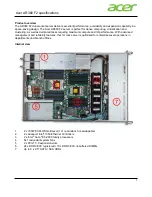
Instruction Manual
7
To connect console devices:
1. Connect a standard PS/2 keyboard to the Local Keyboard port on the front panel of
the SV1115IPEXT.
2. Connect a standard PS/2 mouse to the Local Mouse port on the front panel of the
SV1115IPEXT.
3. Connect a SVGA-compliant monitor to the Video (Out) port on the front panel of
SV1115IPEXT.
4. Power on the host computer.
Disabling Mouse Acceleration on the Host Computer
NOTE: If you are using USB to connect SV1115IPEXT to the host computer, you will not
be required to adjust the mouse settings on the host computer, as this device uses
“Absolute” mode, which eliminates any problems you may otherwise experience with
mouse synchronization or host mouse acceleration.
Many operating systems offer a feature called mouse acceleration, allowing the
user to adjust the responsiveness of the cursor on the screen in relation to physical
movements of the mouse. While this is usually a beneficial interface enhancement, it
can interfere with the operation of the SV1115IPEXT and should be disabled on the
host computer before a remote session is attempted. Follow the instructions below to
disable mouse acceleration for the operating system installed on the host computer.
Windows 98
1. From the Control Panel, click on Mouse.
2. From Mouse Properties, click on the Motion tab.
3. Make sure the Pointer speed bar is centered and Acceleration is set to None.
Windows 2000
1. From the Control Panel, Click on Mouse.
2. From Mouse properties, click on the Motion tab.
3. Make sure that the Pointer speed bar is centered and Acceleration is set to None.
Windows XP and Windows Server 2003
1. Go to Pointer Options and turn off Enhance Pointer Precision and ensure that the
pointer speed bar is centered.
Linux, Unix and X-Windows
1. Add this command to your xinitrc, xsession or other startup script:
xset m 0/0 0 (For more information, please refer to Troubleshooting)












































